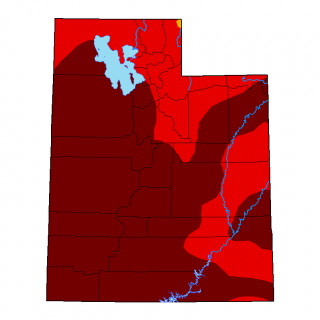July 1 Water Supply Outlook Report for Utah

Current Valley Conditions (SCAN)
Utah’s Valley locations ended up with an average of 0.3 inches of precipitation again in June. The 2021 water year total now stands at a paltry 4.1 inches of precipitation, on average, at Utah’s SCAN sites. As was the case in previous months, Southwestern Utah fared poorly in June and subsequently soil moisture values are very low. Recent storm activity in the region should help this improve the situation. Soil temperatures across the state mirrored the exceptionally high air temperatures during June. Thankfully, both moderated at the end of the month. Drought conditions deteriorated slightly during June, with the entire state persisting at Moderate (D1) to Exceptional (D4) drought. The portion of Utah experiencing Exceptional Drought now stands at a very discouraging 64%.
Current Mountain Conditions (SNOTEL)
When it comes to water supply conditions in Utah’s mountains, June was not the month we were looking for. Last month’s accumulated precipitation was only 31% of normal, bringing the water-year-to-date accumulation to 64%. Statewide soil moisture is at 38% of saturation, compared with 52% last year. Unless we receive significant precipitation this summer and fall, we will enter next year’s snowpack season with another soil moisture deficit, which will again necessitate an above-average snowpack just to get average runoff. As noted in our Water Supply Outlook Reports this spring, we anticipated that we would receive alarmingly low runoff from last winter’s snow due to the dry soils and below-average snow water equivalent levels which, unfortunately, turned out to be correct. Most streams in Utah have already delivered the majority of water supply related to snowmelt. In numerous cases, the total volume of streamflow received was either the lowest or the second-lowest quantity ever recorded for those locations. … Utah’s reservoir storage is currently at 58% of capacity, which is 26% lower than last year at this time. Statewide storage has already dropped 11% from its peak at the beginning of May and can be projected to decline to a low of roughly 40% capacity based on a 25% annual drop seen during other recent dry years. Importantly, Utah’s reservoirs are very unlikely to see substantial gains until next spring’s runoff. Based on current precipitation and soil moisture conditions, we really need next winter’s snowpack to be outstanding to preclude a continued decline in our reservoir storage levels. However, we could potentially be looking at statewide reservoir storage in the 15-20% of capacity range (or worse) by the end of next summer if conditions remain similar to this year. Water managers should take note of this potential outcome. … These water supply conditions are causing Utah’s current Water Availability Indices (WAIs) to drop to historically-low levels (bottom 10th percentile) for 10 of Utah’s 18 major basins, and to extremely-low levels (bottom 20th percentile) for all other basins except for the Bear, Virgin, and Smith’s Creek watersheds, as shown in the summary table on subsequent pages.
For the entire report, please click here.

